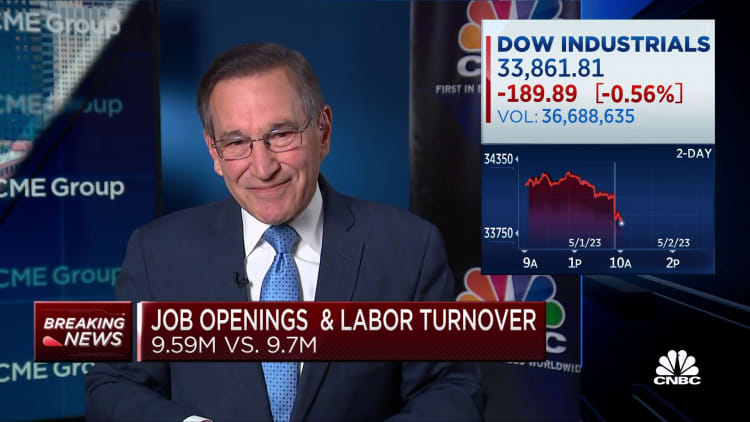Maskot | Digitalvision | Getty Images
The job market is still hot but is clearly slowing from the scorching levels seen during much of the past two years, according to labor experts.
Job openings and voluntary worker departures (or, quits) declined in March, while the layoff rate increased, according to data issued Tuesday by the U.S. Bureau of Labor Statistics.
“Two words: unambiguous cooldown,” Nick Bunker, director of North American economic research at job site Indeed, said of the data in the Job Openings and Labor Turnover Survey.
More from Personal Finance:
Mastering this skill is the ‘hardest part’ of personal finance, advisors say
69% of people either failed or barely passed this Social Security quiz
What to know about climbing credit card interest rates
That said, the job market remains favorable for workers despite the recent cooling trend. By many metrics, it’s stronger than pre-pandemic levels in 2019, when it was also robust, economists said. The national 3.5% unemployment rate in March ties for the lowest since 1969.
“If you’re looking at the current temperature of the labor market, it’s still strong, still hot,” Bunker said.
It’s unclear if the cooling will continue and at what speed.
The Federal Reserve began raising borrowing costs aggressively last year to cool the economy and labor market, aiming to tame stubbornly high inflation. And a pullback in lending — exacerbated by recent turmoil in the banking sector — may apply an additional brake on the U.S. economy.

Here’s what the latest data tell us about the job market.
1. Job openings
Job openings — a proxy of employers’ demand for workers — dropped to a two-year low in March.
Openings decreased to 9.6 million in March, a drop of 384,000 from February, according to JOLTS data.
Job openings kept breaking records as the U.S. economy reopened in the pandemic era. Businesses clamored to hire workers, and openings eventually peaked above 12 million in March 2022.
Now, openings are down by 1.6 million from December — a “pretty rapid pullback,” Bunker said — and are at their lowest level since April 2021.
There are also 1.6 job openings for every unemployed worker, the lowest ratio since October 2021.
However, openings remain well above their pre-pandemic baseline. For example, there were about 7.2 million job openings a month, on average, in 2019.
Small businesses with fewer than 50 employees seem to have led the decline in overall job openings in March, said Julia Pollak, chief economist at ZipRecruiter.
While the number of job openings in the private sector declined by 4.7%, the decline was sharper (8.9%) among small businesses, she said, citing JOLTS data.
Tighter lending conditions generally have a bigger impact on small businesses and “are likely hindering their ability to invest and grow,” she said.
2. Quits
The so-called Great Resignation trend continued to wane in March.
About 3.9 million workers quit their jobs in March, a modest decline of 129,000 from February. However, these voluntary departures have fallen by about 650,000 from about a year ago, when quits were near record highs.
Quits are a proxy for worker confidence that they can find another job, since those who leave often do so for new employment.
High employee turnover in restaurants has been a major driver of sky-high wage growth in recent months, but that may soon come to an end.
Julia Pollak
chief economist at ZipRecruiter
The numbers are still about 10% higher than pre-pandemic levels, but “also falling in a sign that workers are growing less confident in their ability to quit [and] find new jobs amidst a cooling job market,” said Daniel Zhao, lead economist at job site Glassdoor.
The slowdown was most pronounced in accommodation and food services, which includes businesses like restaurants and hotels. The quits rate declined by 1.3 percentage points over the month — more than double the rate of other industries, according to JOLTS data.
“High employee turnover in restaurants has been a major driver of sky-high wage growth in recent months, but that may soon come to an end,” Pollak said.
3. Layoffs
There was a sharp uptick in layoffs during March.
The layoff rate increased to 1.2%, the highest level since December 2020, from 1%.
The jump in layoffs is “the most concerning figure” from the JOLTS report, Zhao said. The number of layoffs rose by 248,000 over the month, to about 1.8 million — which is “near the pre-pandemic level after spending much of the last [two] years well below, amidst a historically hot job market,” he said.
The sharpest increase was in the construction sector — where one would expect the economic fallout from higher borrowing costs to first hit the labor market, due partly to higher mortgage costs, Bunker said.
However, economists would need to see if that trend persists beyond the month before drawing negative conclusions, he added.
 EU News Digest Latest News & Updates
EU News Digest Latest News & Updates



